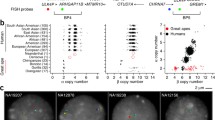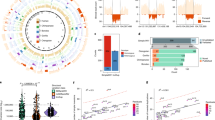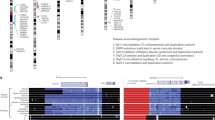Abstract
The human-specific pericentric inversion of chromosome 18 was analysed using breakpoint-spanning BACs from the chimpanzee and human genome. Sequence and FISH analyses disclosed that the breakpoints map to an inverted segmental duplication of 19-kb, which most likely mediated the inversion by intrachromosomal homologous recombination. The 19-kb duplication encompasses the 3′ end of the ROCK1 gene and occurred in the human lineage. Only one copy of this segment is found in the chimpanzee. Due to the inversion, the genomic context of the ROCK1 and USP14 genes is altered. ROCK1 flanks USP14 in the long arm of the chimpanzee chromosome 17, which is homologous to human chromosome 18. This order is interrupted by the inversion in humans. ROCK1 is localized close to the pericentromeric region in 18q11 and USP14 is inverted to distal 18p11.3 in direct neighbourhood to LSAU-satellites, β-satellites and telomere-associated repeats. Our findings essentially confirm the analysis of Dennehey et al. (2004). Intriguingly, USP14 is differentially expressed in human and chimpanzee cortex as well as fibroblast cell lines determined previously by the analysis of oligonucleotide arrays. Either position effects mediated by the proximity to the telomeric region or nucleotide divergence in regulatory regions might account for the differential expression of USP14. The assignment of the breakpoint region to a segmental duplication underlines the significance of the genomic architecture in the context of genome and karyotype evolution in hominoids.





Similar content being viewed by others
References
Caceres M, Lachuer J, Zapala MA, Redmond JC, Kudo L, Geschwind DH, Lockhart DJ, Preuss TM, Barlow C (2003) Elevated gene expression levels distinguish human from non-human primate brains. Proc Natl Acad Sci USA 100:13030–13035
Dennehey BK, Gutches DG, McConkey EH, Krauter KS (2004) Inversion, duplication, and changes in gene context are associated with human chromosome 18 evolution. Genomics 83:493–501
Enard W, Khaitovich P, Klose J, Zollner S, Heissig F, Giavalisco P, Nieselt-Struwe K, Muchmore E, Varki A, Ravid R, Doxiadis GM, Bontrop RE, Paabo S (2002). Intra- and interspecific variation in primate gene expression patterns. Science 296:340–343
Fan Y, Linardopoulou E, Friedman C, Williams E, Trask BJ (2002) Genomic structure and evolution of the ancestral chromosome fusion site in 2q13-2q14.1 and paralogous regions on other human chromosomes. Genome Res 12:1651–1662
Hellmann I, Zollner S, Enard W, Ebersberger I, Nickel B, Paabo S (2003). Selection on human genes as revealed by comparisons to chimpanzee cDNA. Genome Res 13:831–837
Karaman MW, Houck ML, Chemnick LG, Nagpal S, Chawannakul D, Sudano D, Pike BL, Ho VV, Ryder OA, Hacia JG (2003). Comparative analysis of gene-expression patterns in human and African great ape cultured fibroblasts. Genome Res 13:1619–1630
Kehrer-Sawatzki H, Schreiner B, Taenzer S, Platzer M, Muller S, Hameister H (2002) Molecular characterization of the pericentric inversion that causes differences between chimpanzee chromosome 19 and human chromosome 17. Am J Hum Genet 71:375–388
Locke DP, Archidiacono N, Misceo D, Cardone MF, Deschamps S, Roe B, Rocchi M, Eichler EE (2003) Refinement of a chimpanzee pericentric inversion breakpoint to a segmental duplication cluster. Genome Biol 4:R50
McConkey EH (1997). The origin of human chromosome 18 from a human/ape ancestor. Cytogenet Cell Genet 76:189–191
Samonte RV, Eichler EE (2002) Segmental duplications and the evolution of the primate genome. Nat Rev Genet 3:65–72
Stankiewicz P, Lupski JR (2002) Genome architecture, rearrangements and genomic disorders. Trends Genet 18:74–82
Stankiewicz P, Park SS, Inoue K, Lupski JR (2001) The evolutionary chromosome translocation 4;19 in Gorilla gorilla is associated with microduplication of the chromosome fragment syntenic to sequences surrounding the human proximal CMT1A-REP. Genome Res 11:1205–1210
Yoder AD, Yang Z (2000). Estimation of primate speciation dates using local molecular clocks. Mol Biol Evol 17:1081–90
Yunis JJ, Prakash O (1982) The origin of man: a chromosomal pictorial legacy. Science 215:1525–1530
Acknowledgements
This research was funded by the Deutsche Forschungsgemeinschaft (DFG KE 724/2-1).
Author information
Authors and Affiliations
Corresponding author
Rights and permissions
About this article
Cite this article
Goidts, V., Szamalek, J.M., Hameister, H. et al. Segmental duplication associated with the human-specific inversion of chromosome 18: a further example of the impact of segmental duplications on karyotype and genome evolution in primates. Hum Genet 115, 116–122 (2004). https://doi.org/10.1007/s00439-004-1120-z
Received:
Accepted:
Published:
Issue Date:
DOI: https://doi.org/10.1007/s00439-004-1120-z




